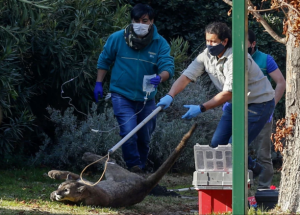
As we enter the fall months of the year, September is “Save a Tiger Month.” As you read this article, please be aware of the actions you can do to help the tigers stay and survive in the wild. Tigers are beautiful animals that live primarily in Asia. Tigers today can be found on the IUNC Endangered Species Red List.
The Subspecies of Tigers
There are 9 subspecies of tigers, and 3 of them are already extinct. These subspecies include Caspian, Bali, Javan, Sumatran, Malayan, Indochinese, Siberian, Bengal, and South China tigers.
Extinct
Caspian tigers became extinct in the 1970s and lived in the river basins of China and Asia. The Bali tiger has been extinct since the 1930s and was found in the Sunda Islands. The Javan tiger has also been extinct since the 1970s, and they lived across the Indonesian Islands.
Alive
Sumatran tigers live more south in the fragmented Indonesian Islands. They are the sole survivors in the Sunda Islands since the Bali and Javan tigers are extinct. There are approximately 600 of these tigers in the wild therefore putting them on the endangered species list.
The Malayan tiger is native to Peninsular Malaysia, living along rivers and forests. The Malayan tiger is critically endangered, and there are thought to be less than 200 left in the wild.
Indochinese tigers live in Southeast Asia, mainly in Thailand and Myanmar, and can be found on the endangered species list.
The South China tiger has been found all over China and is critically endangered.
Siberian tigers now live in the remote parts of northeast China and far east Russia. There are believed to be less than 600 of these animals in the wild today.
Bengal tigers can be found across Nepal, India, and Bangladesh, with roughly less than 4,000 left in the wild.
The Issues
The population of these animals is steadily decreasing in the wild due to many reasons: habitat loss, poaching, illegal trade, climate change, and human-wildlife conflict.
 Habitat loss is a big reason why there are approximately 5,500 tigers in the wild today. Their habitat has been destroyed by human activity for agriculture, timber, road development, modernization, and the elimination of habitat to grow palm oil plantations. Tigers need to have a large area to survive and thrive as they are very territorial animals.
Habitat loss is a big reason why there are approximately 5,500 tigers in the wild today. Their habitat has been destroyed by human activity for agriculture, timber, road development, modernization, and the elimination of habitat to grow palm oil plantations. Tigers need to have a large area to survive and thrive as they are very territorial animals.
 Poaching and illegal trade are other significant problems tigers face in the wild. From their whiskers to their tails, tiger parts can be found in the illegal wildlife trade markets. Their bones are used in Tiger Bone Wine and modern health tonics and remedies, while their furs are used in different cultures as status symbols.
Poaching and illegal trade are other significant problems tigers face in the wild. From their whiskers to their tails, tiger parts can be found in the illegal wildlife trade markets. Their bones are used in Tiger Bone Wine and modern health tonics and remedies, while their furs are used in different cultures as status symbols.
Climate change is another reason that is causing their population to decrease. One of the largest tiger populations currently lives in the Sundarbans National Forest, which is a large mangrove coastal forest found on the border of India and Bangladesh. The rising sea level is threatening the existence of these tigers and the habitat they currently live in.
 Human-wildlife conflict is another issue these animals face. As these animals’ habitats are declining, as said in the statements above, tigers have moved closer to the human population, where they can hurt livelihoods and destroy livestock or even people. You can learn more about human-wildlife conflict by checking out one of our educational blogs, What is Human-Wildlife Conflict?
Human-wildlife conflict is another issue these animals face. As these animals’ habitats are declining, as said in the statements above, tigers have moved closer to the human population, where they can hurt livelihoods and destroy livestock or even people. You can learn more about human-wildlife conflict by checking out one of our educational blogs, What is Human-Wildlife Conflict?
What you Can Do to Help
Some organizations are trying to help with the conservation efforts for tigers. The World Wildlife Foundation is trying to help these conservation efforts. They are monitoring the tigers and prey for these animals. They also strive to educate the world and get their message out politically to gain support from other people in order to eliminate the illegal tiger trade.
There are some ways that we, as the general public, can help out in order to help protect tigers from becoming extinct. We can speak up and help those organizations make a change. Also, we can volunteer our time to help out. We can donate to and for the cause; World Wildlife Foundation is a credited source to donate to. Another place to donate is the Global Federation of Animal Sanctuaries, Home Page – Global Federation of Animal Sanctuaries.

We can also educate others about what is happening to tigers in the wild. This all takes time, and some of it even takes money, but if we don’t change the world now, these animals will become extinct in the wild very soon. Remember tigers as the month goes on, and try to think of additional ways you might be able to help save the tigers.

Sources
https://www.worldwildlife.org/species/tiger
https://www.aza.org/
https://www.npr.org/2022/08/07/1116218424/the-tiger-count-in-nepal-has-tripled-in-recent-years
https://panthera.org/cat/tiger
https://www.wcs.org/our-work/species/tigers
https://www.iucn.org/
https://www.iucnredlist.org/species/15955/214862019
